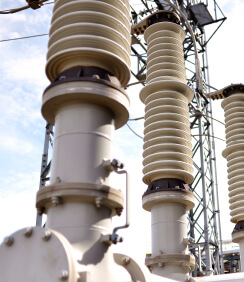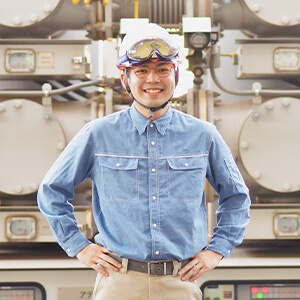-
- 08:30Arrive at workAfter checking my email, I read the operation team's handover logbook to see if there are any signs of failure or any other problems with the equipment.10:00Equipment maintenance planI compile a maintenance plan in advance of the parts replacement time for motors, which is the equipment that I manage.12:00LunchAfter enjoying a lunch set at the company cafeteria, I take a short break.13:00Maintenance arrangementI prepare construction specifications for replacement parts and place construction request orders to subcontractors.16:00Team meetingI reconfirm information about the construction date and determine plans for the day.17:00Return home
INTERVIEW
Facilities Management Group
Electric and Instrument Team
Yuta Uchino
Various electrical facilities are in operation at the plant that "receive" power from TEPCO, "generate" power in-house, "distribute" power by adjusting the received and generated power to a specified voltage, and "transmit" power to the companies for which we are the power suppliers. To ensure a stable supply of electrical power, our Electric and Instrument Team routinely inspects all of these facilities from the viewpoint of preventive maintenance and performs maintenance to prevent failures.
Another important task is the design of modifications that will not only maintain the status quo, but also improve current power generation facilities. In my second year with the company, I was also entrusted with the task of upgrading the two highest-capacity power lines in the plant to enable more flexible operation. Thus far, the use of each of these circuits had been determined based on receiving and distributing power, which placed significant restrictions on the availability for periodic repairs and limited the measures that could be taken in the event of the occurrence of sudden issues. We were able to eliminate these operational restrictions to a great extent and modified the facility to enable flexible operation in all cases.
Our knowledge and technology have finally caught up with the level of the manufacturers and we are finally able to take the lead on planning.
Failure is not an option when conducting equipment retrofitting work. This was a project involving high levels of responsibility, as any errors in the design or construction might affect the entire southern power generation facility. The most important work, which accounts for the majority of the modifications, was the enhancement of the "protective coordination equipment" that disconnects the accident point within the shortest possible time in the event of an electrical accident and continues to supply power to normal circuits. I worked with the manufacturer on the design of this equipment, but in the first few months I lacked the necessary skill in reading the drawings and was unable to understand the manufacturer's proposal.
Nevertheless, as I read through the huge volume of more than 200 drawings, I gradually began to grasp the whole picture. I even reached the level where I was able to make proposals as well. As design and construction proceeded, we completed a series of unit tests with favorable results, and it was truly like a weight had been lifted from our shoulders. At the same time, I felt that I had acquired valuable experience and that my technical skills had improved significantly.

I want to further hone my skills by continuing to learn and do work of which the junior members of my team will be proud.
Currently, we are preparing for the replacement of the aging turbine electrical equipment. The task was to renew the complete set of power supply equipment to operate a 60 MW class turbine generator, in addition to its auxiliary equipment. Here, too, we would not be able to start the turbines if construction were to be delayed. The construction work must always proceed according to plan and requires reliable process control.
As I have been entrusted with these important projects one after another, I feel that the company has high expectations for my growth. What I admire in the senior staff who have supported me on a daily basis is their approach in terms of never neglecting self-improvement and continuing to study, even after becoming experts in utilizing the equipment. I continue to learn from these senior staff members, and am eagerly trying to improve my skills. Unless I do so, I will never reach the level of my seniors. In a few years, I hope to be more confident in my skills than I am now and be able to do a job of which my junior colleagues will be proud.


- PROFILE
- (Yuta Uchino)
- I studied the theory of electricity at university, but I am interested in how equipment is actually operated in society. I joined the company because I was attracted by the fact that I could be involved in all aspects of power receiving, generation, transmission and distribution.




I started snowboarding last season.
Now I am looking forward
to the arrival of winter.I have always traveled when time permits, and last season I made my snowboarding debut at a ski resort in Fukushima. I was a complete beginner, so I kept falling down at first. However, my friend, who was quite proficient at it, carefully taught me how to ski. In the end, I managed to ski from the top to the bottom of the slope, despite falling a few times. This uniquely refreshing feeling is addictive, and I am looking forward to the arrival of the snowboarding season this winter.





